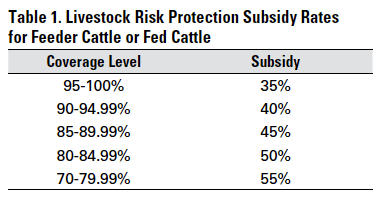Securing Success: Bagley Risk Management Solutions
Securing Success: Bagley Risk Management Solutions
Blog Article
Recognizing Livestock Risk Security (LRP) Insurance Coverage: A Comprehensive Overview
Browsing the world of animals threat defense (LRP) insurance can be an intricate undertaking for numerous in the agricultural industry. From exactly how LRP insurance coverage operates to the various coverage choices available, there is much to uncover in this extensive overview that could potentially form the method animals manufacturers approach danger administration in their services.

Just How LRP Insurance Functions
Occasionally, understanding the mechanics of Livestock Danger Protection (LRP) insurance can be intricate, but breaking down exactly how it works can offer clearness for herdsmans and farmers. LRP insurance policy is a risk administration device designed to protect livestock manufacturers versus unanticipated rate decreases. It's vital to keep in mind that LRP insurance is not an income assurance; instead, it focuses only on rate risk protection.
Eligibility and Coverage Options

When it comes to coverage choices, LRP insurance policy uses manufacturers the adaptability to pick the coverage level, coverage period, and endorsements that finest fit their threat monitoring requirements. Insurance coverage degrees commonly range from 70% to 100% of the expected ending value of the insured livestock. Manufacturers can additionally pick coverage periods that line up with their production cycle, whether they are guaranteeing feeder cattle, fed livestock, swine, or lamb. Recommendations such as rate threat protection can additionally personalize insurance coverage to safeguard against unfavorable market changes. By comprehending the qualification requirements and protection alternatives readily available, animals manufacturers can make educated decisions to handle danger effectively.
Pros and Disadvantages of LRP Insurance Coverage
When evaluating Animals Threat Security (LRP) insurance, it is necessary for livestock manufacturers to evaluate the advantages and disadvantages inherent in this danger management device.

Among the key advantages of LRP insurance is its capacity to supply security versus a decrease in livestock costs. This can help guard manufacturers from financial losses resulting from market variations. Additionally, LRP insurance policy provides a level of adaptability, enabling producers to personalize coverage levels and plan periods to suit their particular needs. By securing an assured rate for their livestock, producers can better handle risk and strategy for the future.
One limitation of LRP insurance policy is that it does not shield versus all kinds of dangers, such as illness episodes or natural catastrophes. It is crucial for producers to carefully examine their specific danger direct exposure and monetary scenario to figure out if LRP insurance is the best risk monitoring tool for their procedure.
Comprehending LRP Insurance Premiums

Tips for Maximizing LRP Benefits
Maximizing the advantages of Animals Risk Security (LRP) insurance policy requires tactical preparation and aggressive risk management - Bagley Risk Management. To take advantage of your LRP protection, consider the complying with pointers:
On A Regular Basis Analyze Market Conditions: Stay informed about market trends and cost changes in the livestock market. By checking these variables, you can make educated decisions regarding when to buy LRP protection to shield versus possible losses.
Establish Realistic Coverage Levels: When picking insurance coverage degrees, consider your manufacturing prices, market worth of animals, and prospective dangers - Bagley Risk Management. Setting sensible protection levels makes sure that you are properly safeguarded without paying too much for unneeded insurance coverage
Diversify Your Protection: Rather of relying solely on LRP insurance, take into consideration diversifying your risk management methods. Integrating LRP with other threat monitoring devices such as futures agreements or choices can offer extensive coverage versus market uncertainties.
Review and Adjust Insurance Coverage Consistently: As market conditions transform, periodically review your LRP insurance coverage to ensure it aligns with your present threat direct exposure. Readjusting coverage degrees and timing of purchases can aid enhance your risk security approach. By adhering to these suggestions, you can make best use of the advantages of LRP insurance coverage and secure your livestock procedure versus unforeseen threats.
Conclusion
Finally, livestock threat protection (LRP) insurance policy is a useful tool for farmers to handle the economic risks associated with their livestock procedures. By understanding just how LRP works, qualification and insurance coverage options, along with the advantages and disadvantages of this insurance policy, farmers can make informed choices to protect their source of look at this now incomes. By meticulously thinking about LRP premiums and implementing methods to optimize advantages, farmers can mitigate potential losses and make certain the sustainability of their operations.
Animals producers interested in getting Animals Danger Defense (LRP) insurance can explore a variety of qualification requirements and insurance coverage alternatives customized to their specific livestock operations.When it comes to insurance coverage alternatives, LRP insurance policy provides producers the versatility to select the protection level, protection period, and recommendations that best suit their risk management demands.To grasp the intricacies of Livestock Danger Defense (LRP) insurance policy totally, recognizing the factors influencing LRP insurance costs is crucial. LRP insurance premiums are identified by various aspects, consisting of the protection level picked, the anticipated cost of livestock at the end of the coverage duration, the type of animals being insured, and the size of the insurance coverage period.Review and Readjust Coverage Frequently: As market conditions alter, regularly assess your LRP protection to ensure it aligns with your existing danger exposure.
Report this page